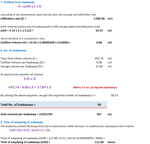Soakaway Calc. Full

Description
<p>Ashghal, the Public Works Authority in Qatar, is responsible for designing and implementing stormwater management systems, including soakaways. Soakaways are drainage systems that allow surface water to infiltrate into the ground, reducing the risk of flooding and water pollution. Here is a summary of stormwater soakaway design calculation based on Ashghal guidelines:</p>
<ol>
<li>
<p>Site investigation: Conduct a thorough site investigation to gather data on soil type, infiltration rates, groundwater levels, and nearby structures or utilities. This information will help to determine the feasibility of a soakaway system and inform the design process.</p>
</li>
<li>
<p>Rainfall estimation: Use local rainfall data to estimate the rainfall intensity for the design storm event (e.g., a 1 in 100-year storm). This will help determine the volume of water the soakaway must be able to handle.</p>
</li>
<li>
<p>Catchment area calculation: Calculate the catchment area contributing to the soakaway, considering factors such as roof area, paved surfaces, and any other impermeable surfaces. The catchment area will help determine the volume of runoff generated during the design storm event.</p>
</li>
<li>
<p>Infiltration rate calculation: Determine the infiltration rate of the soil using field tests, such as double-ring infiltrometer tests or falling head permeability tests. The infiltration rate is crucial to understanding how quickly the soil can absorb the stormwater.</p>
</li>
<li>
<p>Storage volume calculation: Calculate the required storage volume for the soakaway by multiplying the catchment area by the rainfall depth during the design storm event, and then dividing by the infiltration rate. This will give the required storage volume to handle the design storm event.</p>
</li>
<li>
<p>Soakaway sizing: Size the soakaway based on the required storage volume, considering factors such as available space, excavation depth, and required setback distances from nearby structures or utilities. Common soakaway designs include trenches, pits, and modular systems made from various materials like concrete, plastic, or stone.</p>
</li>
<li>
<p>Safety factors and maintenance: Apply appropriate safety factors and design considerations to ensure the soakaway will function effectively over its intended lifespan. Plan for regular inspections and maintenance to prevent blockages, ensure performance, and extend the service life of the system.</p>
</li>
</ol>
<p>By following these steps and adhering to Ashghal guidelines, an effective stormwater soakaway design can be developed that manages runoff, reduces the risk of flooding, and protects the environment.</p>
<p>In stormwater soakaway design, there are two primary methods for calculating the required storage volume: the Simple Method and the Full (Rational) Method. Here's an overview of both methods:</p>
<ol>
<li>Simple Method: This method is a quick and straightforward approach to estimate the required storage volume of a soakaway. It's often used for small-scale projects or preliminary assessments. The formula for the Simple Method is:</li>
</ol>
<p>Storage Volume (V) = Catchment Area (A) × Rainfall Depth (R) × Runoff Coefficient (C)</p>
<ul>
<li>Catchment Area (A): The total area of impervious surfaces contributing to the soakaway, such as rooftops, driveways, and paved areas.</li>
<li>Rainfall Depth (R): The depth of rainfall during the design storm event, typically provided by local meteorological data.</li>
<li>Runoff Coefficient (C): A dimensionless value representing the fraction of rainfall that becomes runoff. It varies based on the type of surface (e.g., asphalt, concrete, grass) and typically ranges from 0.0 (no runoff) to 1.0 (all rainfall becomes runoff).</li>
</ul>
<p>The Simple Method assumes a constant infiltration rate and doesn't account for factors such as soil infiltration rate, storage, or detention time.</p>
<ol start="2">
<li>Full (Rational) Method: The Full or Rational Method is a more comprehensive approach to calculating the required storage volume for a soakaway. It takes into account factors like soil infiltration rate, storage, and detention time. The steps for the Full Method include:</li>
</ol>
<p>a. Calculate the peak runoff rate (Q) using the Rational Method formula:</p>
<p>Peak Runoff Rate (Q) = Catchment Area (A) × Rainfall Intensity (i) × Runoff Coefficient (C)</p>
<ul>
<li>Rainfall Intensity (i): The maximum rainfall intensity for the design storm event, typically provided by local meteorological data (e.g., Intensity-Duration-Frequency (IDF) curves).</li>
</ul>
<p>b. Determine the inflow hydrograph by plotting the relationship between peak runoff rate and time.</p>
<p>c. Calculate the infiltration capacity of the soil, using the soil infiltration rate and the surface area of the soakaway.</p>
<p>d. Determine the outflow hydrograph by subtracting the infiltration capacity from the inflow hydrograph.</p>
<p>e. Calculate the required storage volume by finding the difference between the inflow and outflow hydrographs, and selecting the maximum volume.</p>
<p>The Full (Rational) Method provides a more accurate estimate of the required storage volume for a soakaway, especially for complex or large-scale projects. However, it's more time-consuming and requires more detailed data than the Simple Method.</p>
<p>In summary, the Simple Method offers a quick and easy way to estimate the required storage volume for a soakaway, while the Full (Rational) Method provides a more comprehensive and accurate approach. The choice of method depends on the scale and complexity of the project, as well as the availability of data.</p>Calculation Preview
Full download access to any calculation is available to users with a paid or awarded subscription (XLC Pro).
Subscriptions are free to contributors to the site, alternatively they can be purchased.
Click here for information on subscriptions.
Comments: 1
×
johndoyle-admin
2 years ago
Thanks for your contribution I have awarded a 3 month extension to your XLC Pro subscription by way of thanks. [Admin]



